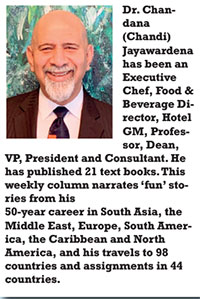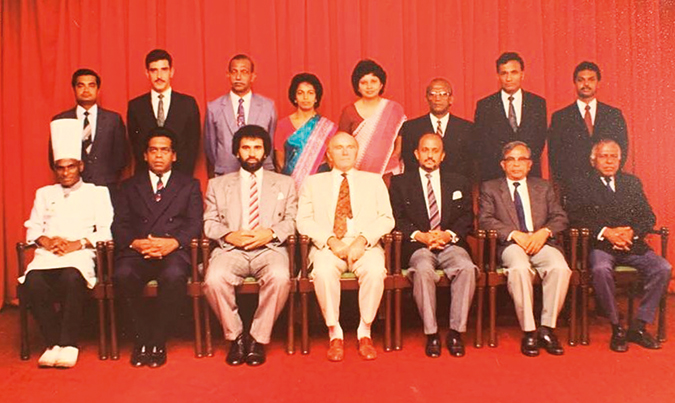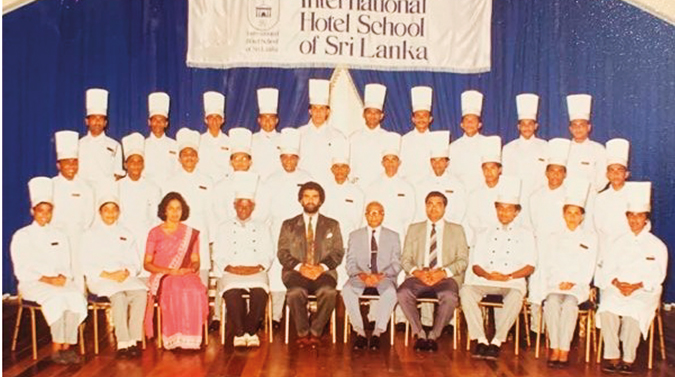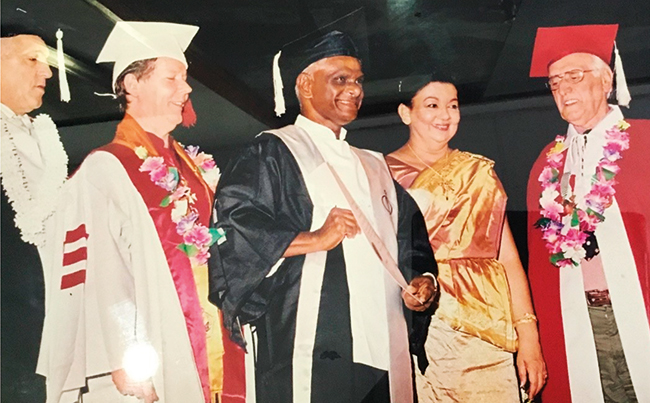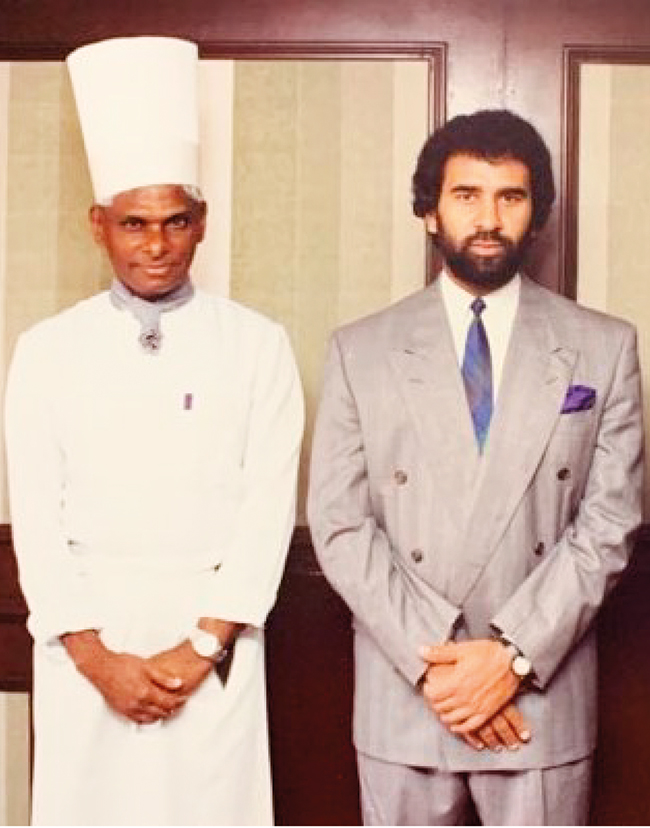Features
Deshabandu Dr. T. Publis Silva Longest-standing Sri Lankan Chef and National Treasure
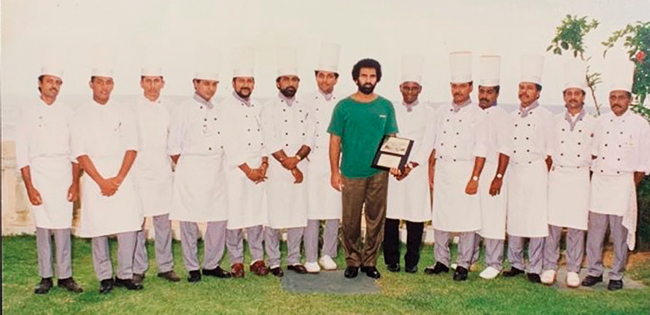
PLACES, PEOPLE & PASSIONS (3Ps)
Part six
Dr. Chandana (Chandi) Jayawardena DPhil
President – Chandi J. Associates Inc. Consulting, Canada
chandij@sympatico.ca
Profile
Publis is a household name in Sri Lanka as a chef, author, TV personality, and to many, a national treasure. He joined Mount Lavinia Hotel in 1956 as a kitchen labourer. In the early-1970s he was trained by the Hyatt Corporation in USA, who managed the hotel at that time. Publis was promoted as the Executive Chef in 1984, and then promoted as the Director Culinary Affairs & Promotions in 2003, a position he has held for 20 years. During his 67-year long career at Mount Lavinia Hotel, he also did a stint in the Maldives and was responsible for organizing numerous Sri Lankan food festivals and promotions in 33 countries.
I first met Publis Silva in 1972 at the Mount Lavinia Hyatt Hotel, when he was the Assistant Chef, and I was a Trainee Waiter. The next time I met him was in 1990 and we worked closely as the Executive Chef and the General Manager. We then co-wrote a book which was the maiden attempt in book publishing by each of us. After I left Sri Lanka in 1994 we kept in touch, and he made sure that I received a signed copy of each of his books. Today I am his proudest fan.
First Impressions in 1972
By early 1970s Mount Lavinia Hotel (MLH) became the first ever hotel in Ceylon to get an international brand name. Hyatt Hotels Corporation in USA managed MLH. At that time, to graduate from the Ceylon Hotel School (CHS), each student had to do two mandatory co-op placements or in-service periods. Four of my CHS batchmates and I were fortunate to be allocated to MLH for our first in-service in 1972/1973 tourist season.
After the American General Manager from Hyatt corporation, Robert McFadden, met with us on our first day, we were introduced to a few key members of the hotel team, including Publis Silva, who was the Assistant Chef of MLH at that time. He was in his mid-thirties, and I was in my late teens.
My first impression of Publis was special. By then he had worked in the MLH kitchens for 16 years and gradually had risen to the second in command position of the kitchen department. He had also undergone training with three European Executive Chefs sent to MLH by Hyatt.
After the departure of those expatriate chefs, Just before the 1972/1973 tourist season, the hotel had appointed an Acting Executive Chef, a young Sri Lankan from a prominent family in Colombo, who was trained by Publis. I watched how Publis treated this young chef with respect and fully supporting him. Publis is a professional who always respected superiors, irrespective of their level of experience or knowledge.
Christmas of 1972
I remember Publis leading the kitchen brigade in preparing the Christmas Eve dinner in 1972. I sought Chef Publis’s help in understanding some of the dishes I was not familiar with. Despite being very busy that day Publis went into detailed explanations in Sinhala. He wanted us to be well-informed Trainee Waiters. With the additional knowledge I gained by talking with Publis, I managed to earn some extra tips that evening. He was always very helpful and friendly.
Working in the same team in 1990
Eighteen years later In 1990, when I returned to MLH as the General Manager, Publis worked on my team as the Executive Chef. I quickly appreciated that Publis is a great asset to the hotel. Whatever task I delegated to him was done promptly and efficiently. His knowledge of the history of MLH, and the culture of the company were useful to me in settling down in my new and the last job position in Sri Lanka.
Publis was the first to come to work every day and did the longest shift, among all managers. He hardly took any off days, and never needed any sick leave. He was always healthy and fit as a fiddle. MLH was and is his temple. When we worked together on new à la carte menus, I realized that Publis was also open to new suggestions. When the owners of MLH agreed to my suggestion to establish an International Hotel School (IHS) within MLH, Publis became a big supporter of my vision.
Establishing IHS in 1991
IHS was launched with a bang in 1991. It was an immediate success with five international accreditations and pathways and students from five countries. I worked as the Managing Director of IHS and Publis worked as the Adviser in Culinary courses. We also established a Program Advisory Committee with experts from ten countries and introduced for the first time in Sri Lanka, ‘Hotel Administration’ seminars for senior managers. At the end of the 22-week culinary program of IHS, Publis choreographed a classical menu with 13 dishes, cooked, and served by IHS students. We invited all the Executive Chefs of five-star hotels in Colombo for this meal.
Getting into Book Publishing in 1992
One day Publis came to me with a suggestion for a new food promotion. “Sir, how about doing a mushroom promotion? We have a wide variety of mushrooms in Sri Lanka, but unknown to many.” After a brief discussion, I was very impressed with Publis’s wide knowledge of the subject. I learnt a lot from him about mushrooms. “OK, Chef. Let’s move forward with your suggestion. Can you produce a small booklet about mushrooms?” I planted a seed in his mind. Within a few days he found a sponsor to print the booklet. Publis was always prompt in making things happen.
The ‘Mushroom Week’ of MLH was held from 24th to 30th April 1991, in association with the Ceylon Tourist Board, the Mushroom Development and Training Centre and Export Development Board. The booklet compiled by Publis was sold for US$ 2.50 a copy. That was the beginning of the most outstanding journey of writing and publishing books on Sri Lankan gastronomy, by the longest-standing Sri Lanka chef.
After the success of the mushroom promotion, I wanted to explore other possibilities to showcase Publis’s amazing research and knowledge about local ingredients and traditional dishes. He was doing in-depth research on dishes specifically prepared for the royal families of the Kandyan kingdom, prior to 1815. However, when I suggested that he should author a ground-breaking Sri Lankan cookbook, Publis declined citing his lack of knowledge of the English language. I said to him, “why don’t you write the book in Sinhala?”, but he was too shy to undertake such a project.
I did not give up. I twisted his arm occasionally and gently, but it took a year before he agreed, on one condition. That was: I must work as his co-author. I agreed, but he did most of the work. My key contributions were writing a short introduction and finding a publisher. In 1992 we published ‘Sinhala Bojana’ in Sinhala and in 1993 we published ‘Traditional Sri Lankan Food’ in English.
After that, I left Sri Lanka, and we did not collaborate for scholarly publications, but proceeded with our own subjects of interest. Publis continued in creating the greatest volume of books dedicated to Sri Lankan food. I focused mainly on international hospitality management, tourism, and innovation. With those two books, both Publis and I commenced a 31-year journey of book writing and publishing, cumulatively totalling 47 books, so far…
Best Manager in 1993
The Chairman of MLH, Mr. Sanath Ukwatte and I decided to select the ‘Best Manager’ of the hotel in early 1993. Being such a generous person, the Chairman decided to present a car to the winner. We had an excellent team at MLH, but our choice was easy. We picked Publis and rewarded him with the prize of a car.
After my three-year expatriate contract, I left MLH in December 1993 and a few months later I left Sri Lanka for good to focus on my international career. On my last day at MLH, while my family was packing our bags to leave, Publis called me. When he said, “Sir, may I see you with our farewell present?”, I told him, “Chef, the management team already presented me with presents, last evening during the farewell party.” “No Sir, I want to come with my senior team of Chefs to give you something special.” Within a few minutes Publis and his team of 12 Sous Chefs and Chef de Partie came to my apartment at MLH and presented me with an engraved plaque.
A Loyal and Grateful Friend from 1994 to 2023
After 1994 I have stayed at MLH many times as a guest during family holidays, doing consulting assignments, presenting leadership development seminars, and doing a few IHS re-structuring projects. I chose MLH as the venue for two of my most important life events – the home coming wedding reception for my wife in 1999, and my 50th birthday party in 2003. On those two occasions, I never looked at the menu. When Publis asked me what I want in the menu I simply told him, “You decide on the menu, Chef. Anything good for you is good for me.” On both these special occasions, just as I expected, Chef Publis exceeded my expectations.
When it comes to memorable and magical events, there is no better venue than MLH, and no better Chef than Publis. MLH has been my home away from home during the last 30 years. Meanwhile, Publis made sure that I received a signed copy of each of his books. Every time he was generous with his appreciation and thanks for getting him to write and publish in 1992. Despite my repeated reminders to him that I don’t deserve such praise, Publis has been disobedient in that regard.
On April 20, 2023, while on a seven-week holiday in Sri Lanka I received a message through a friend that Dr. Publis Silva wants to see me before my departure. When he heard that I ws being hosted to dinner at Ellen’s Place – an inn in Colombo eight, by a few hotelier friends, Publis showed up early. Unfortunately, my previous engagement was delayed by an hour, and poor Publis stayed on patiently in spite of his family having a religious ceremony at his house on the same evening.
After a brief chat he presented me with a signed copy of his latest book: ‘MAHASUPAWAMSAYA: The Great Chronicle of Sri Lankan Culinary Art’. I glance through the book to find that it has a total of 1,074 pages! Chef Publis never ceased to amaze me!
I was deeply touched with the message that he hand wrote on the front page of the book he presented to me. It said: “This is presented to you, who supported me and encouraged me to write books.” For over 50 years, the privilege has been mine to get many opportunities to associate with the greatest Sri Lankan Chef, who is indeed a National Treasure.
Questions and Answers
After I returned to Canada, soon after our last meeting in 2023, I sent the following ten questions to Deshabandu Dr. T. Publis Silva:
Q: Out of all the places you have visited in Sri Lanka and overseas, what is your favourite and most interesting place?
A: Mount Lavinia Hotel and I are inseparable. Hence, I can proudly say that my favourite place out of every country and city I have ever been to is, Mount Lavinia (Galkissa).
Q: You have inspired generations of culinary professionals. Thinking of the other side of the coin, in your career, who inspired you most?
A: In 1950s, the first à la carte restaurant in Ceylon was opened at MLH and its kitchen was developed and managed by Bass (Head Cook) R. K. M. Silva.He was a real inspiration for me and taught me a lot of valuable lessons. After his passing, to pay my respects, I created a dish named after him called “Seer RKM.” and placed it in menus across the hotel, as well as in my books, especially the Sinhalese Practical Cookery book which was used in many culinary schools and institutions across Sri Lanka.
Q: At the present time, apart from cooking, researching, and writing, what is your key passion in life?
A: To make food that is medicine is my current key passion and goal in life. This mainly includes using the abundant varieties of fruits, vegetables, legumes, seeds, cereals, and beans to dishes which are brimming with health properties. To add into it, the art of putting love and attention into the food we make while being mindful in the whole cooking process ensures we keep the maximum nutrition value of the food while preserving the flavour and the aroma of the food.
In the modern world, non-contagious diseases such as diabetes and cancer are more prevalent and deadly and eating the right type of food can ensure we can prevent or control these diseases.
Q: Can you tell our readers about your interesting adventures before joining MLH in 1956?
A: As a kid of six years old, I used to go to the beach in Ratgama with my friends and the entire beach was ours to explore. I remember we used to pluck coconuts from the trees, husk and crack the shells and then eat the kernel. One day when a piece of kernel fell in the sand, I washed it with sea water. When I ate it I experienced a better taste. This was one of my initial curiosities into the culinary world.
When I was around 20 years old, without a job and after marriage, I used to push carts in Colombo to earn a living. My passengers usually head for the market to sell produce and usually there were leftovers. I used to pick them up and then cook dishes from those.
I remember the first time I used a leftover karawala (dry salted fish) bone in a vegetable curry, the flavour made me feel like I was in heaven and to-date, that was the best food I remember having experienced. These are a few of my stories about the hardships I faced and how I developed a passion for cooking.
Q: In 1970 when MLH became the first hotel in Sri Lanka to be managed by an international hotel chain, what did you learn from the Hyatt Corporation, USA?
A: Hyatt Corporation brought in international chefs and I with all our MLH kitchen staff learned a lot from them. I especially learned about butchery and meat from French, German and Swiss chefs and I respect them for further igniting my passion to research about all kinds of food.
Q: Can you give the readers some numbers from your 67-year long career in culinary arts – total number of books, TV shows, food festivals, weddings catered for (including BMICH) etc.?
A: I have written 20 books, attended a countless number of TV shows, and I remember celebrating the 10,000th wedding catered when Dr. Chandana Jayawardena was the General Manager of MLH. In 1992, as the long-standing catering partner of BMICH – national convention centre, MLH did the catering for the largest wedding to be held in Sri Lanka. We prepared and served 2,400 invitees a sit-down Biriyani dinner within 90-minutes. I must mention that Dr. Chandana Jayawardena was also the person who pushed me into writing more books and my first book was written along with his collaboration. I have also visited 33 countries to promote Sri Lankan food and culture.
Q: You have recorded numerous achievements, including two Guinness World Records, an honorary doctorate, and the national award of Deshabandu. What do you consider as your greatest achievement during the last 77 years?
A: The greatest achievement for me was the Guiness World Record for the world’s largest milk rice ever made. It contained 1000kg of rice and 2000kg of coconuts. During that huge undertaking, it felt like I was the conductor of a symphony orchestra with 120 chefs. They were ready to obey each command, I told them when to add the rice, when to add the milk, when to add the water, when to lower the fire, and finally, the end-product which was 62 feet long and five feet wide was a world record breaking milk rice with a consistent flavour and each piece was enjoyed by those who attended to witness the world record.
Q: Your book MAHASUPAVANSHAYA, has over 1,000 pages and you led a large team of researchers in producing this book. Tell our readers more about that remarkable process ?
A: It took me and my team over 30 years to complete the book, we went across Sri Lanka gathering a vast volume of information and our research took us to some parts in Africa as well. Professors and students from Sri Jayewardenepura University helped me a lot along with a team of 12 chefs from MLH. During my research, while learning about the history of culinary arts in Sri Lanka, I learned that during the time of King Dutugamunu, they used a Stone Oruwa (a stone boat) filled it with water, filled it with heated rocks and that brought the water to a heated temperature, which ultimately made the Stone Oruwa act as a chafing dish to keep any food containers placed inside hot. This was the first recorded usage of a chafing dish in the world.
Q: What does a normal day of the Director Culinary Affairs and Promotions of MLH, look like?
A: The first thing I do when I arrive at my office in the morning is to search for new innovations in the culinary field. I keep myself as a student and learn new things every day. I ensure that anything I learn I teach to the next generation and then search for new innovations again. This cycle encapsulates my normal day as the Director of Culinary Affairs and Promotions. For example, my thinking of culinary innovation led me to learn that, if we take the Kos Tree (Jak Fruit Tree), there are abundant uses we have, and each piece of the entire Kos Tree can be used in some culinary way.
Q: What is your advice to young chefs who dream of having a long career in culinary arts?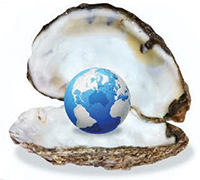
A: In the world, I believe that the best thing someone can learn is to cook, I ask of the entire younger generation to learn cooking as I believe that if anyone learns about cooking, it will be one of the most important and useful skills acquired in life.
Next week, 3Ps will feature a university professor who is also a leader in tourism in Sri Lanka…
Features
The heart-friendly health minister

by Dr Gotabhya Ranasinghe
Senior Consultant Cardiologist
National Hospital Sri Lanka
When we sought a meeting with Hon Dr. Ramesh Pathirana, Minister of Health, he graciously cleared his busy schedule to accommodate us. Renowned for his attentive listening and deep understanding, Minister Pathirana is dedicated to advancing the health sector. His openness and transparency exemplify the qualities of an exemplary politician and minister.
Dr. Palitha Mahipala, the current Health Secretary, demonstrates both commendable enthusiasm and unwavering support. This combination of attributes makes him a highly compatible colleague for the esteemed Minister of Health.
Our discussion centered on a project that has been in the works for the past 30 years, one that no other minister had managed to advance.
Minister Pathirana, however, recognized the project’s significance and its potential to revolutionize care for heart patients.
The project involves the construction of a state-of-the-art facility at the premises of the National Hospital Colombo. The project’s location within the premises of the National Hospital underscores its importance and relevance to the healthcare infrastructure of the nation.
This facility will include a cardiology building and a tertiary care center, equipped with the latest technology to handle and treat all types of heart-related conditions and surgeries.
Securing funding was a major milestone for this initiative. Minister Pathirana successfully obtained approval for a $40 billion loan from the Asian Development Bank. With the funding in place, the foundation stone is scheduled to be laid in September this year, and construction will begin in January 2025.
This project guarantees a consistent and uninterrupted supply of stents and related medications for heart patients. As a result, patients will have timely access to essential medical supplies during their treatment and recovery. By securing these critical resources, the project aims to enhance patient outcomes, minimize treatment delays, and maintain the highest standards of cardiac care.
Upon its fruition, this monumental building will serve as a beacon of hope and healing, symbolizing the unwavering dedication to improving patient outcomes and fostering a healthier society.We anticipate a future marked by significant progress and positive outcomes in Sri Lanka’s cardiovascular treatment landscape within the foreseeable timeframe.
Features
A LOVING TRIBUTE TO JESUIT FR. ALOYSIUS PIERIS ON HIS 90th BIRTHDAY

by Fr. Emmanuel Fernando, OMI
Jesuit Fr. Aloysius Pieris (affectionately called Fr. Aloy) celebrated his 90th birthday on April 9, 2024 and I, as the editor of our Oblate Journal, THE MISSIONARY OBLATE had gone to press by that time. Immediately I decided to publish an article, appreciating the untiring selfless services he continues to offer for inter-Faith dialogue, the renewal of the Catholic Church, his concern for the poor and the suffering Sri Lankan masses and to me, the present writer.
It was in 1988, when I was appointed Director of the Oblate Scholastics at Ampitiya by the then Oblate Provincial Fr. Anselm Silva, that I came to know Fr. Aloy more closely. Knowing well his expertise in matters spiritual, theological, Indological and pastoral, and with the collaborative spirit of my companion-formators, our Oblate Scholastics were sent to Tulana, the Research and Encounter Centre, Kelaniya, of which he is the Founder-Director, for ‘exposure-programmes’ on matters spiritual, biblical, theological and pastoral. Some of these dimensions according to my view and that of my companion-formators, were not available at the National Seminary, Ampitiya.
Ever since that time, our Oblate formators/ accompaniers at the Oblate Scholasticate, Ampitiya , have continued to send our Oblate Scholastics to Tulana Centre for deepening their insights and convictions regarding matters needed to serve the people in today’s context. Fr. Aloy also had tried very enthusiastically with the Oblate team headed by Frs. Oswald Firth and Clement Waidyasekara to begin a Theologate, directed by the Religious Congregations in Sri Lanka, for the contextual formation/ accompaniment of their members. It should very well be a desired goal of the Leaders / Provincials of the Religious Congregations.
Besides being a formator/accompanier at the Oblate Scholasticate, I was entrusted also with the task of editing and publishing our Oblate journal, ‘The Missionary Oblate’. To maintain the quality of the journal I continue to depend on Fr. Aloy for his thought-provoking and stimulating articles on Biblical Spirituality, Biblical Theology and Ecclesiology. I am very grateful to him for his generous assistance. Of late, his writings on renewal of the Church, initiated by Pope St. John XX111 and continued by Pope Francis through the Synodal path, published in our Oblate journal, enable our readers to focus their attention also on the needed renewal in the Catholic Church in Sri Lanka. Fr. Aloy appreciated very much the Synodal path adopted by the Jesuit Pope Francis for the renewal of the Church, rooted very much on prayerful discernment. In my Religious and presbyteral life, Fr.Aloy continues to be my spiritual animator / guide and ongoing formator / acccompanier.
Fr. Aloysius Pieris, BA Hons (Lond), LPh (SHC, India), STL (PFT, Naples), PhD (SLU/VC), ThD (Tilburg), D.Ltt (KU), has been one of the eminent Asian theologians well recognized internationally and one who has lectured and held visiting chairs in many universities both in the West and in the East. Many members of Religious Congregations from Asian countries have benefited from his lectures and guidance in the East Asian Pastoral Institute (EAPI) in Manila, Philippines. He had been a Theologian consulted by the Federation of Asian Bishops’ Conferences for many years. During his professorship at the Gregorian University in Rome, he was called to be a member of a special group of advisers on other religions consulted by Pope Paul VI.
Fr. Aloy is the author of more than 30 books and well over 500 Research Papers. Some of his books and articles have been translated and published in several countries. Among those books, one can find the following: 1) The Genesis of an Asian Theology of Liberation (An Autobiographical Excursus on the Art of Theologising in Asia, 2) An Asian Theology of Liberation, 3) Providential Timeliness of Vatican 11 (a long-overdue halt to a scandalous millennium, 4) Give Vatican 11 a chance, 5) Leadership in the Church, 6) Relishing our faith in working for justice (Themes for study and discussion), 7) A Message meant mainly, not exclusively for Jesuits (Background information necessary for helping Francis renew the Church), 8) Lent in Lanka (Reflections and Resolutions, 9) Love meets wisdom (A Christian Experience of Buddhism, 10) Fire and Water 11) God’s Reign for God’s poor, 12) Our Unhiddden Agenda (How we Jesuits work, pray and form our men). He is also the Editor of two journals, Vagdevi, Journal of Religious Reflection and Dialogue, New Series.
Fr. Aloy has a BA in Pali and Sanskrit from the University of London and a Ph.D in Buddhist Philosophy from the University of Sri Lankan, Vidyodaya Campus. On Nov. 23, 2019, he was awarded the prestigious honorary Doctorate of Literature (D.Litt) by the Chancellor of the University of Kelaniya, the Most Venerable Welamitiyawe Dharmakirthi Sri Kusala Dhamma Thera.
Fr. Aloy continues to be a promoter of Gospel values and virtues. Justice as a constitutive dimension of love and social concern for the downtrodden masses are very much noted in his life and work. He had very much appreciated the commitment of the late Fr. Joseph (Joe) Fernando, the National Director of the Social and Economic Centre (SEDEC) for the poor.
In Sri Lanka, a few religious Congregations – the Good Shepherd Sisters, the Christian Brothers, the Marist Brothers and the Oblates – have invited him to animate their members especially during their Provincial Congresses, Chapters and International Conferences. The mainline Christian Churches also have sought his advice and followed his seminars. I, for one, regret very much, that the Sri Lankan authorities of the Catholic Church –today’s Hierarchy—- have not sought Fr.
Aloy’s expertise for the renewal of the Catholic Church in Sri Lanka and thus have not benefited from the immense store of wisdom and insight that he can offer to our local Church while the Sri Lankan bishops who governed the Catholic church in the immediate aftermath of the Second Vatican Council (Edmund Fernando OMI, Anthony de Saram, Leo Nanayakkara OSB, Frank Marcus Fernando, Paul Perera,) visited him and consulted him on many matters. Among the Tamil Bishops, Bishop Rayappu Joseph was keeping close contact with him and Bishop J. Deogupillai hosted him and his team visiting him after the horrible Black July massacre of Tamils.
Features
A fairy tale, success or debacle

Sri Lanka-Singapore Free Trade Agreement
By Gomi Senadhira
senadhiragomi@gmail.com
“You might tell fairy tales, but the progress of a country cannot be achieved through such narratives. A country cannot be developed by making false promises. The country moved backward because of the electoral promises made by political parties throughout time. We have witnessed that the ultimate result of this is the country becoming bankrupt. Unfortunately, many segments of the population have not come to realize this yet.” – President Ranil Wickremesinghe, 2024 Budget speech
Any Sri Lankan would agree with the above words of President Wickremesinghe on the false promises our politicians and officials make and the fairy tales they narrate which bankrupted this country. So, to understand this, let’s look at one such fairy tale with lots of false promises; Ranil Wickremesinghe’s greatest achievement in the area of international trade and investment promotion during the Yahapalana period, Sri Lanka-Singapore Free Trade Agreement (SLSFTA).
It is appropriate and timely to do it now as Finance Minister Wickremesinghe has just presented to parliament a bill on the National Policy on Economic Transformation which includes the establishment of an Office for International Trade and the Sri Lanka Institute of Economics and International Trade.
Was SLSFTA a “Cleverly negotiated Free Trade Agreement” as stated by the (former) Minister of Development Strategies and International Trade Malik Samarawickrama during the Parliamentary Debate on the SLSFTA in July 2018, or a colossal blunder covered up with lies, false promises, and fairy tales? After SLSFTA was signed there were a number of fairy tales published on this agreement by the Ministry of Development Strategies and International, Institute of Policy Studies, and others.
However, for this article, I would like to limit my comments to the speech by Minister Samarawickrama during the Parliamentary Debate, and the two most important areas in the agreement which were covered up with lies, fairy tales, and false promises, namely: revenue loss for Sri Lanka and Investment from Singapore. On the other important area, “Waste products dumping” I do not want to comment here as I have written extensively on the issue.
1. The revenue loss
During the Parliamentary Debate in July 2018, Minister Samarawickrama stated “…. let me reiterate that this FTA with Singapore has been very cleverly negotiated by us…. The liberalisation programme under this FTA has been carefully designed to have the least impact on domestic industry and revenue collection. We have included all revenue sensitive items in the negative list of items which will not be subject to removal of tariff. Therefore, 97.8% revenue from Customs duty is protected. Our tariff liberalisation will take place over a period of 12-15 years! In fact, the revenue earned through tariffs on goods imported from Singapore last year was Rs. 35 billion.
The revenue loss for over the next 15 years due to the FTA is only Rs. 733 million– which when annualised, on average, is just Rs. 51 million. That is just 0.14% per year! So anyone who claims the Singapore FTA causes revenue loss to the Government cannot do basic arithmetic! Mr. Speaker, in conclusion, I call on my fellow members of this House – don’t mislead the public with baseless criticism that is not grounded in facts. Don’t look at petty politics and use these issues for your own political survival.”
I was surprised to read the minister’s speech because an article published in January 2018 in “The Straits Times“, based on information released by the Singaporean Negotiators stated, “…. With the FTA, tariff savings for Singapore exports are estimated to hit $10 million annually“.
As the annual tariff savings (that is the revenue loss for Sri Lanka) calculated by the Singaporean Negotiators, Singaporean $ 10 million (Sri Lankan rupees 1,200 million in 2018) was way above the rupees’ 733 million revenue loss for 15 years estimated by the Sri Lankan negotiators, it was clear to any observer that one of the parties to the agreement had not done the basic arithmetic!
Six years later, according to a report published by “The Morning” newspaper, speaking at the Committee on Public Finance (COPF) on 7th May 2024, Mr Samarawickrama’s chief trade negotiator K.J. Weerasinghehad had admitted “…. that forecasted revenue loss for the Government of Sri Lanka through the Singapore FTA is Rs. 450 million in 2023 and Rs. 1.3 billion in 2024.”
If these numbers are correct, as tariff liberalisation under the SLSFTA has just started, we will pass Rs 2 billion very soon. Then, the question is how Sri Lanka’s trade negotiators made such a colossal blunder. Didn’t they do their basic arithmetic? If they didn’t know how to do basic arithmetic they should have at least done their basic readings. For example, the headline of the article published in The Straits Times in January 2018 was “Singapore, Sri Lanka sign FTA, annual savings of $10m expected”.
Anyway, as Sri Lanka’s chief negotiator reiterated at the COPF meeting that “…. since 99% of the tariffs in Singapore have zero rates of duty, Sri Lanka has agreed on 80% tariff liberalisation over a period of 15 years while expecting Singapore investments to address the imbalance in trade,” let’s turn towards investment.
Investment from Singapore
In July 2018, speaking during the Parliamentary Debate on the FTA this is what Minister Malik Samarawickrama stated on investment from Singapore, “Already, thanks to this FTA, in just the past two-and-a-half months since the agreement came into effect we have received a proposal from Singapore for investment amounting to $ 14.8 billion in an oil refinery for export of petroleum products. In addition, we have proposals for a steel manufacturing plant for exports ($ 1 billion investment), flour milling plant ($ 50 million), sugar refinery ($ 200 million). This adds up to more than $ 16.05 billion in the pipeline on these projects alone.
And all of these projects will create thousands of more jobs for our people. In principle approval has already been granted by the BOI and the investors are awaiting the release of land the environmental approvals to commence the project.
I request the Opposition and those with vested interests to change their narrow-minded thinking and join us to develop our country. We must always look at what is best for the whole community, not just the few who may oppose. We owe it to our people to courageously take decisions that will change their lives for the better.”
According to the media report I quoted earlier, speaking at the Committee on Public Finance (COPF) Chief Negotiator Weerasinghe has admitted that Sri Lanka was not happy with overall Singapore investments that have come in the past few years in return for the trade liberalisation under the Singapore-Sri Lanka Free Trade Agreement. He has added that between 2021 and 2023 the total investment from Singapore had been around $162 million!
What happened to those projects worth $16 billion negotiated, thanks to the SLSFTA, in just the two-and-a-half months after the agreement came into effect and approved by the BOI? I do not know about the steel manufacturing plant for exports ($ 1 billion investment), flour milling plant ($ 50 million) and sugar refinery ($ 200 million).
However, story of the multibillion-dollar investment in the Petroleum Refinery unfolded in a manner that would qualify it as the best fairy tale with false promises presented by our politicians and the officials, prior to 2019 elections.
Though many Sri Lankans got to know, through the media which repeatedly highlighted a plethora of issues surrounding the project and the questionable credentials of the Singaporean investor, the construction work on the Mirrijiwela Oil Refinery along with the cement factory began on the24th of March 2019 with a bang and Minister Ranil Wickremesinghe and his ministers along with the foreign and local dignitaries laid the foundation stones.
That was few months before the 2019 Presidential elections. Inaugurating the construction work Prime Minister Ranil Wickremesinghe said the projects will create thousands of job opportunities in the area and surrounding districts.
The oil refinery, which was to be built over 200 acres of land, with the capacity to refine 200,000 barrels of crude oil per day, was to generate US$7 billion of exports and create 1,500 direct and 3,000 indirect jobs. The construction of the refinery was to be completed in 44 months. Four years later, in August 2023 the Cabinet of Ministers approved the proposal presented by President Ranil Wickremesinghe to cancel the agreement with the investors of the refinery as the project has not been implemented! Can they explain to the country how much money was wasted to produce that fairy tale?
It is obvious that the President, ministers, and officials had made huge blunders and had deliberately misled the public and the parliament on the revenue loss and potential investment from SLSFTA with fairy tales and false promises.
As the president himself said, a country cannot be developed by making false promises or with fairy tales and these false promises and fairy tales had bankrupted the country. “Unfortunately, many segments of the population have not come to realize this yet”.
(The writer, a specialist and an activist on trade and development issues . )

